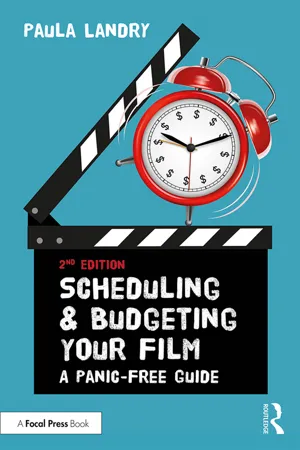
- 328 pages
- English
- ePUB (mobile friendly)
- Available on iOS & Android
About this book
Budgeting and scheduling are easy in principle but hard in practice. The successful producer has a solid plan for juggling dozens of activities and costs while retaining the flexibility to cope with those inevitable last-minute changes and stay on course. Preplanning the budget and schedule of any media project is absolutely essential, and the 2nd edition of Scheduling and Budgeting Your Film: A Panic-Free Guide shows you the intricacies of handling both budgeting and scheduling successfully.
This new and updated edition explains the fundamentals of line producing in an easy-to-understand style, and includes tips and techniques that apply no matter what kind of scheduling or budgeting software you're using. Author Paula Landry includes detailed examples of breakdown forms, organizing resources, distribution expenses, and hidden costs, and discusses how to set realistic priorities and find industry and state tax incentives. The new edition also includes discussions of transmedia and multi-purpose shooting, special considerations for VR, 4K and 3D shooting, new web platforms and mobile technology, crowd funding, film festivals, and much more.
- Each chapter is filled with handy checklists, tips, practical advice, and anecdotes, showing how scheduling and budgeting are done in the real world;
- Principles apply to any type of media project: film, video, music video, projects hosted online, and corporate and educational videos;
- An accompanying eResources page offers downloadable forms and templates, and other essential resources.
Frequently asked questions
- Essential is ideal for learners and professionals who enjoy exploring a wide range of subjects. Access the Essential Library with 800,000+ trusted titles and best-sellers across business, personal growth, and the humanities. Includes unlimited reading time and Standard Read Aloud voice.
- Complete: Perfect for advanced learners and researchers needing full, unrestricted access. Unlock 1.4M+ books across hundreds of subjects, including academic and specialized titles. The Complete Plan also includes advanced features like Premium Read Aloud and Research Assistant.
Please note we cannot support devices running on iOS 13 and Android 7 or earlier. Learn more about using the app.
Information
Chapter One
Schedule and Budget Basics

- Identifying
- Organizing and Scheduling
- Locating and Pricing
- Budgeting and Securing
The Schedule and Budget Relationship

| Equipment | Vendor | Days | Cost |
| Tripod | DCTV | 1 | $20.00 |
| 2 | $40.00 | ||
| 3 | $60.00 | ||
| Entire Week (6 day) | $80.00 |
Who Manages the Schedule and Budget
Table of contents
- Cover
- Title
- Copyright
- Dedication
- Contents
- Acknowledgements
- Introduction
- Chapter One—Schedule and Budget Basics
- Chapter Two—Identifying Resources: The Breakdown
- Chapter Three—Organizing Resources: The Schedule
- Chapter Four—Pricing Resources: The Budget
- Chapter Five—Helpful Scheduling and Budgeting Tips
- Chapter Six—Managing Resources
- Chapter Seven—Special Considerations
- Chapter Eight—Additional Topics You are Bound to Encounter
- Index